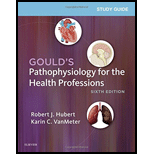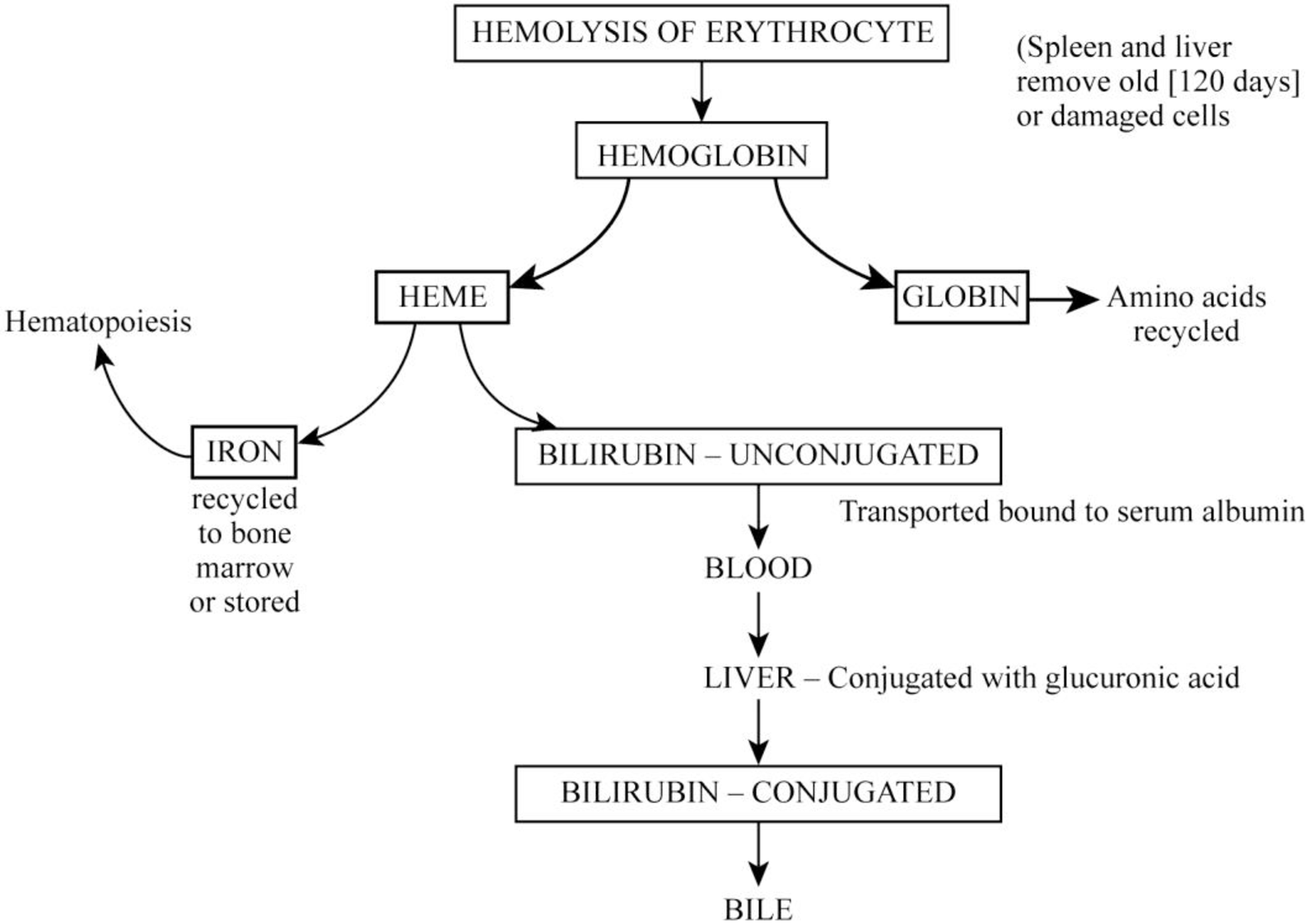
To describe: The life cycle of an erythrocyte, including where it is produced, what is its lifespan and where and how it is destroyed.
Introduction: Erythrocytes, also known as red blood cells (RBCs), form the important constituent of the blood cells. They are typically biconcave disks and are non- nucleated. They consist of a pigment “Hemoglobin”, which gives red color to the blood and plays an important role in transportation of oxygen throughout the body.
Explanation of Solution
The process of production of RBC is called erythropoiesis. Erythropoiesis occurs in the red bone marrow, which includes flat bones that are present in hips, skull, ribs and vertebrae. The primary sources for erythropoiesis are the pluripotent hematopoietic stem cells. The progenitor for the formation of RBC is the megakaryocyte–erythroid progenitor cell. Proerythroblast, basophilic erythroblast, polychromatic erythroblast, and reticulocytes are formed at the initial stages of RBC formation. Finally, the reticulocytes give rise to mature biconcave erythrocytes. The total life span of RBC is about 120 days after which it is degraded in the spleen or liver. After its life span is over, hemoglobin present in RBC is split into its components namely “heme” and “globulin”. The protein part “globin” is degraded into its constituent amino acids and is recycled back. The heme part of hemoglobin can be recycled in two ways. The iron from heme is either recycled back to bone marrow for the process of hematopoiesis or it is used in bilirubin synthesis. In the liver, heme is conjugated with glucoronide so that it becomes more soluble and then it is excreted in the bile.
Pictorial representation: Fig.1 represents the recycling process of erythrocyte.

Fig.1 Recycling process of erythrocyte.
RBCs are produced in red bone marrow, and their life span is nearly 120 days. Destruction or recycling of RBC occurs in the spleen or liver.
Want to see more full solutions like this?
Chapter 10 Solutions
Study Guide for Gould's Pathophysiology for the Health Professions
- how is mental health nursing independent from general nursing?arrow_forwardThe importance of monitoring resident's wound healing (bed sores, cuts, and scrapes, etc.) and how can a nutritionist utilize this in their career? Please not just a short explanation.arrow_forwardThe importance of seeing how it is to work as a chief in a nursing home and how they accommodate for special diets (low sodium, low sugar, heart healthy, etc.) and how can a nutritionist utilize this in their career? Please not just a short explanation.arrow_forward
- The importance of dealing with work confrontation (different healthcare departments fighting; diet aide and CNA) as a manager of a kitchen and how can a nutritionist utilize this in their career? Please not just a short explanation.arrow_forwardQuestion 1: You are the Community Dietitian for the local public health agency. Recent news coverage has highlighted the state of food insecurity and child hunger in your county. Initial reports indicate that 15% of the population is food insecure. Of this group, 28.4% are children. It is estimated that 86% of the food insecure population is eligible for federal nutrition assistance. You are asked to conduct a community needs assessment and, ultimately, develop an appropriate intervention aimed at reducing hunger. First, however, you must submit a plan for the needs assessment. Complete the following: 1. State the nutritional problem (10 pts) 2. Set the parameters of the assessment (20 pts, 5 pts per bullet) A. State the purpose of the assessment B. Identify the community and target population for this assessment C. Develop 2 goals and 2 SMART objectives for each goal D. Discuss the major categories of community data and target population data E. Specify the types of data you might…arrow_forwardAssignment Instructions: Nursing Research Essay Objective: Select a specific area of nursing that captivates your interest. Compose a comprehensive essay, ranging from 300 to 500 words, that delves into the intricacies of nursing research within your chosen area. It is recommended that you consider the topic carefully as this topic, should be the topic for your course research project: see week 4 assignments. Your essay should elucidate the following points: The Significance of Nursing Research: Explore how nursing research in your selected area contributes to advancements in applied medicine. Discuss the potential achievements and innovations that can arise from dedicated nursing research in this field. Articulate the value and impact of such research on patient care, healthcare practices, and overall medical knowledge. Research Methods and Approaches: Identify the most effective methods for conducting nursing research in your chosen area. Highlight specific topics or research…arrow_forward
- The importance of understanding low meal consumption of residents in a nursing home and how can a nutritionist utilize this in their career? Please not just a short explanation.arrow_forwardThe importance of accommodating special diets (diabetic, low sodium, etc.) in a nursing home and how can a nutritionist utilize this in their career? Please not just a short explanation.arrow_forwardThe importance of making a weekly clean list for kitchen staff in a nursing home and how can a nutritionist utilize this in their career? Please not just a short explanation.arrow_forward
- The importance of keeping a clean food pantry in a nursing home and how can a nutritionist utilize this in their career? Please not just a short explanation.arrow_forwardI’m finding it a bit difficult to understand the Arrhenius equation and how shelf life relates to pH and temperature. Also in the question that says ‘this solution maintains 80% potency at 30C’, am I correct in thinking the formula would be:t = ln(0.8)/ -karrow_forward4.24 mmmarrow_forward
 Phlebotomy EssentialsNursingISBN:9781451194524Author:Ruth McCall, Cathee M. Tankersley MT(ASCP)Publisher:JONES+BARTLETT PUBLISHERS, INC.
Phlebotomy EssentialsNursingISBN:9781451194524Author:Ruth McCall, Cathee M. Tankersley MT(ASCP)Publisher:JONES+BARTLETT PUBLISHERS, INC. Gould's Pathophysiology for the Health Profession...NursingISBN:9780323414425Author:Robert J Hubert BSPublisher:Saunders
Gould's Pathophysiology for the Health Profession...NursingISBN:9780323414425Author:Robert J Hubert BSPublisher:Saunders Fundamentals Of NursingNursingISBN:9781496362179Author:Taylor, Carol (carol R.), LYNN, Pamela (pamela Barbara), Bartlett, Jennifer L.Publisher:Wolters Kluwer,
Fundamentals Of NursingNursingISBN:9781496362179Author:Taylor, Carol (carol R.), LYNN, Pamela (pamela Barbara), Bartlett, Jennifer L.Publisher:Wolters Kluwer, Fundamentals of Nursing, 9eNursingISBN:9780323327404Author:Patricia A. Potter RN MSN PhD FAAN, Anne Griffin Perry RN EdD FAAN, Patricia Stockert RN BSN MS PhD, Amy Hall RN BSN MS PhD CNEPublisher:Elsevier Science
Fundamentals of Nursing, 9eNursingISBN:9780323327404Author:Patricia A. Potter RN MSN PhD FAAN, Anne Griffin Perry RN EdD FAAN, Patricia Stockert RN BSN MS PhD, Amy Hall RN BSN MS PhD CNEPublisher:Elsevier Science Study Guide for Gould's Pathophysiology for the H...NursingISBN:9780323414142Author:Hubert BS, Robert J; VanMeter PhD, Karin C.Publisher:Saunders
Study Guide for Gould's Pathophysiology for the H...NursingISBN:9780323414142Author:Hubert BS, Robert J; VanMeter PhD, Karin C.Publisher:Saunders Issues and Ethics in the Helping Professions (Min...NursingISBN:9781337406291Author:Gerald Corey, Marianne Schneider Corey, Cindy CoreyPublisher:Cengage Learning
Issues and Ethics in the Helping Professions (Min...NursingISBN:9781337406291Author:Gerald Corey, Marianne Schneider Corey, Cindy CoreyPublisher:Cengage Learning





